ARJUNA’S PENANCE
 Carved in relief on the face of a huge rock,
Arjuna’s Penance is the mythical story of the River Ganges issuing from
its source high in the Himalaya. The panel (27metres by nine metres)
depicts animals, fables form the Panchatantra,
and Arjuna doing a penanace to obtain a boon from Siva. It’s one of the
freshest, most realistic and unpretentious rock carving in India.
Carved in relief on the face of a huge rock,
Arjuna’s Penance is the mythical story of the River Ganges issuing from
its source high in the Himalaya. The panel (27metres by nine metres)
depicts animals, fables form the Panchatantra,
and Arjuna doing a penanace to obtain a boon from Siva. It’s one of the
freshest, most realistic and unpretentious rock carving in India.
MANDAPAMS
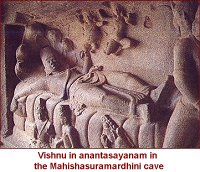 There are eight mandapams (shallow, rock cut halls)
scattered over the main hill, two of which have been left unfinished. They
are mainly of interest for their internal figure sculptures.
There are eight mandapams (shallow, rock cut halls)
scattered over the main hill, two of which have been left unfinished. They
are mainly of interest for their internal figure sculptures.
One
of the earliest rock-cut temples is the Krishna
Mandapam. It features carvings of a pastoral scene showing Krishna
lifting up the Govardhana mountain to protect his kinsfolk from the wrath
of Indra.
RATHAS
These are the architectural prototypes of all
Dravidian
 temples, demonstrating the imposing gopurams and vimanas, multi-pillared halls and sculptured walls which dominate
the landscape of Tamil Nadu. The rathas
are named after the Pandavas, the heroes of the Mahabharata
epic, and are full-size models of different kinds of temples known to
the Dravidian builders of the 7th century AD. With one
exception, the rathas depict structural types which recall the earlier
architecture of the Buddhist temples and monasteries. Though they are
popularly known as the Five Rathas, there are actually eight of them.
temples, demonstrating the imposing gopurams and vimanas, multi-pillared halls and sculptured walls which dominate
the landscape of Tamil Nadu. The rathas
are named after the Pandavas, the heroes of the Mahabharata
epic, and are full-size models of different kinds of temples known to
the Dravidian builders of the 7th century AD. With one
exception, the rathas depict structural types which recall the earlier
architecture of the Buddhist temples and monasteries. Though they are
popularly known as the Five Rathas, there are actually eight of them.
SHORE TEMPLE
This beautiful and romantic temple, ravaged by wind
and sea, represents the final phase of Pallava art and was built in the
late 7th century during the reign of Rajasimha. The temple’s
two spires,
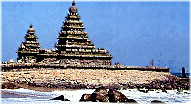 containing a shrine for Vishnu and one for Siva, were modeled after the Dharmaraja Ratha, but with considerable modification. Such is
the significance of the shore temple that it was given World Heritage
listing some years ago. Following that, a huge rock wall was constructed
on the ocean side to minimise further erosion. It’s hardly the most
sensitive of structures but at least the temple is no longer in danger of
being engulfed by the ocean.
containing a shrine for Vishnu and one for Siva, were modeled after the Dharmaraja Ratha, but with considerable modification. Such is
the significance of the shore temple that it was given World Heritage
listing some years ago. Following that, a huge rock wall was constructed
on the ocean side to minimise further erosion. It’s hardly the most
sensitive of structures but at least the temple is no longer in danger of
being engulfed by the ocean.
The
temple is approached through paved forecourts, with weathered perimeter
walls supporting long lines of bulls, and entrances guarded by mythical
deities. Although most of the detail of the carvings has disappeared over
the centuries, a remarkable amount remains, especially inside the shrines.
On Saturdays there is sometimes a free dance programme at the
shore temple. For details, check with the tourist office.
BEACH
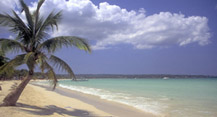 The village itself is only a couple of hundred metres
from the wide beach, north of the shore temple, where local fishers pull
in their boats. The local toilet is also here, and a walk along the beach
is an exercise is sidestepping the turds. South of the shore temple, or
500 metres or so north, it becomes cleaner.
The village itself is only a couple of hundred metres
from the wide beach, north of the shore temple, where local fishers pull
in their boats. The local toilet is also here, and a walk along the beach
is an exercise is sidestepping the turds. South of the shore temple, or
500 metres or so north, it becomes cleaner.
FESTIVAL
From January to February there’s the month-long
Mamallapuram Dance Festival. Dances from all over India are staged here
including Bharatha Natyam (Tamil Nadu), Kathakali (Kerala), Kuchipudi
(Andhra Pradesh) as well as tribal dances, puppet shows and classical /
traditional music. Pick up a leaflet of events at the tourist office in
Madras.
PLACES TO STAY-BOTTOM END
SILVERSANDS BEACH RESORT, (Government Approved)3star
THING TO BUY
Mahabalipuram has revived the ancient crafts of the
Pallava stonemasons and sculptors, and the town wakes every day to the
sound of chisels chipping away at pieces of granite. Some excellent work
is turned out. The yards have contracts to supply images of deities an
restoration pieces to many temples throughout India and Sri lanka. Some
even undertake contract work for the European market. You can buy examples
of this work from the Poompuhar Handicrafts Emporium or from the craft
shops which line the roads down to the shore temple and to the Five-Rathas.
Exquisite soapstone images of Hindu gods, woodcarvings, jewellery
and bangles made from seashells and other similar products are also for
sale.
AROUND MAHABALIPURAM
TIGER CAVE
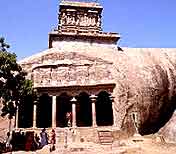 This shady and peaceful place is four km north of
Mahabalipuram and signposted off to the right of the road. It’s more a
clump of boulders than a cave – its name comes from the shrine
(dedicated to Durga) at the entrance which features a crown of carved
tiger heads. It’s a popular picnic spot on weekends.
This shady and peaceful place is four km north of
Mahabalipuram and signposted off to the right of the road. It’s more a
clump of boulders than a cave – its name comes from the shrine
(dedicated to Durga) at the entrance which features a crown of carved
tiger heads. It’s a popular picnic spot on weekends.
TIRUKKALIKUNDRAM
Fourteen km from Mahabalipuram, this pilgrimage
centre is also known as Tirukazhukundram, which means Hill of the Holy
Eagles. Its hilltop temple is famous as the place where two eagles come
each day, just before noon, to be fed by a priest. Legend has it that they
come from Varanasi (Benaras) and are en route to Rameswaram. Five hundred
very steep steps lead to the top of the hill; some less-fit visitors get
themselves carried up in baskets. The actual village is at the base of the
hill and surrounds an amazing temple complex with enormous gopurmas. You
can get here from Mahabalipuram by bus or by bicycle.
CROCODILE BANK
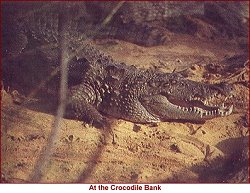 This successful breeding farm was set up to augment
the crocodile population of India’s wildlife sanctuaries. Visitors are
welcome and you can see crocs (some 5000of them) of all sizes. The farm is
about 15km from Mahabalipuram on the road to Madras, and is signposted.
You can get there by bicycle or on any Madras bus from Mahabalipuram.
This successful breeding farm was set up to augment
the crocodile population of India’s wildlife sanctuaries. Visitors are
welcome and you can see crocs (some 5000of them) of all sizes. The farm is
about 15km from Mahabalipuram on the road to Madras, and is signposted.
You can get there by bicycle or on any Madras bus from Mahabalipuram.
VEDANTANGAL BIRD SANCTUARY
About 35km south of Chengalpattu, this is one of the
most spectacular water –bird breeding grounds in India. Cormorants,
egrets, herons, storks, ibises, spoonbills, grebes and pelicans come here
to breed and nest for about six months from October/ November to March,
depending on the monsoons. At the height of the breeding season (December
and January), you can see up to 30,000 birds at once. Many other species
of migratory birds also visit the sanctuary. The best times to visit are
early mornings and late afternoon.
PLACES TO STAY
SILVERSANDS BEACH RESORT, Government Approved) 3 star
Getting to Vedantangal is not all that easy. From
Chengalpattu there are occasional buses to Vedantangal village. Another
alternative is to get a bus to Madurantakam, the closets town of any size,
and then hire transport to take you the last eight km.





